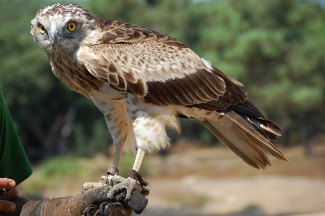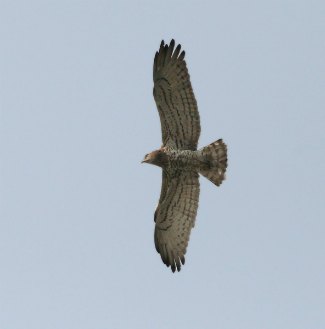Short-Toed Snake Eagle - Circaetus gallicus
By MarioM, CC-BY-SA-3.0, via Wikimedia Commons
Family: Accipitridae
Genus: Circaetus
Species: C. gallicus
Short-Toed Snake Eagles are medium-sized to large raptors that live across a very large range, spanning Europe to Southeast Asia. They form a clade with Terathopius ecaudatus (Bateleur); they also make up a superspecies with Circaetus beaudouini (Beaudouin’s Snake Eagle) and Circaetus pectoralis (Black-Chested Snake Eagle).
Physical Description:
Short-Toed Snake Eagles are brown from above and have a white breast and belly with variable barring and streaking. The flight feathers are dark brown and the tail has three, rarely four, dark bars; females have a slightly longer tail than males. Eyes are bright orange-yellow, and the cere, unfeathered legs, and feet are gray. They closely resemble Circaetus beaudouini (Beaudouin’s Snake Eagle) and Circaetus pectoralis (Black-Chested Snake Eagle) but are paler in color than both of the other species.
Juveniles are similar to adults, except for a rufous tinge to the head and underside, paler wing coverts, and a light-colored throat. The eyes are yellow.
Short Toed Snake Eagles are noisy during the breeding season. Their call is a short, piping whistle, with the females being less musical than the males. Listen to a recording.
They can live up to 17 years in the wild.
Size:
Length: 62-70 cm
Wingspan: 166-188 cm
Weight: Male: 1.2-2 kg. Female: 1.3-2.3 kg.
By Orchi, CC-BY-SA-3.0, via Wikimedia Commons
Habitat and Distribution:
They are found in lowland forest, fields, wetlands, open woodland, grassland, cultivated areas, and desert. They have been recorded as high as 2,300 meters above sea level, but are more common from 0-1,200 m.
They occur in southwestern Europe, northwestern Africa, the Middle East, the Indian subcontinent, Mongolia, Xinjiang Provice in China, and the Sunda Islands. Short-Toed Snake Eagles are complete long-distance migrants, with western populations moving south to winter in sub-Saharan Africa and eastern populations migrating to India, southeast Asia, and the islands of Sumatra, Java, and Bali. In the summer they cover an area from 60°N to 28°N and 34°N to 8°N, and in winter they in habit a region from 16°N to 10°N. There are an estimated 51,000-156,000 individuals over a range of 13,000,000 km².
Diet and Hunting:
As their name would suggest, snakes make up a large part of their diet. In some areas they constitute 70-100% of their prey, and while a majority of the snakes are non-poisonous, some are venomous. Snakes can also be over 150 cm long and are usually eaten whole, starting with the head; chicks three weeks old are capable of swallowing snakes 60-90 mm long. In addition, Short-Toed Snake Eagles eat lizards, toads, frogs, small mammals such as shrews and rabbits, sick or injured birds, and nestlings.
They still-hunt from a perch or in flight around 10-30 m above the ground, though occasionally as high as 450 m. They forage by hovering over an area and diving to catch their prey. They are also known to follow grassland fires for the carcasses of animals who did not escape the flames.
Reproduction:
Breeding displays consist of circling, 15-20 m dives, and other sky dances. The male usually calls frequently. The breeding season is from April-October in the western part of their range and December-May in the eastern half.
The nest is built out of sticks 5-10 cm long and placed in a tree 3-7 meters (rarely 2-25 m) above the ground; less often it is placed on a cliff. It can be 50-75 cm across and 20-25 cm deep—small for a raptor the size of a Short-Toed Snake Eagle—and is lined with green vegetation. Other nests built by birds such as Corvus ruficollis (Brown-Necked Raven) are occasionally used. One egg is laid and incubated for 47 days. Fledging takes 70-80 days and the young leave the nest soon afterwards. They are sexually mature after 3-4 years.
By J.M.Garg, CC-BY-SA-3.0, via Wikimedia Commons
Conservation:
Short-Toed Snake Eagles are widespread and considered common throughout their large range. The population is considered stable, though there was a major decline in the 1800s and 1900s due to shooting and habitat loss. They are currently listed as Least Concern by BirdLife International.
Taxonomy:
It has been found that Circaetus gallicus is related to the Old World vulture genus Aegypius. C. gallicus forms a monophyletic clade with Terathopius ecaudatus (Bateleur), sharing similarities in diet and breeding, and is part of a superspecies that consists of Circaetus beaudouini (Beaudouin’s Snake Eagle) and Circaetus pectoralis (Black-Chested Snake Eagle).
Subspecies:
C. beaudouini, C. pectoralis, and C. fasciolatus (Southern Banded Snake Eagle) were formerly considered subspecies of C. gallicus, but are now classified as separate species.
Other Names:
European Snake Eagle, Short-Toed Harrier Eagle, Short-Toed Serpent Eagle, Turkestan Snake Buzzard, Swartborsslangarend (Afrikaans), Shqipja e gjarpinjve (Albanian), Slangeørn (Danish), Slangenarend (Dutch), Madukotkas (Estonian), Köörmekotka (Finnish), Circaète Jean-le-Blanc (French), Schlangenadler (German), Elangular Jari-pendek (Indonesian), Biancone (Italian), Chouhiwashi (Japanese), Helang Ular (Malay), Gadozer zwyczajny (Polish), Aguila culebrera, Culebrera europea (Spanish), Ormörn (Swedish), Eryr byrfys (Welsh).
Video of Short-Toed Snake Eagles:
References:
http://www.arkive.org/short-toed-snake-eagle/circaetus-gallicus/
http://avibase.bsc-eoc.org/species.jsp?avibaseid=8372FFBAA4080FBB
BirdLife International (2012) Species factsheet: Circaetus gallicus. Downloaded from http://www.birdlife.org on
20/02/2012.
http://blx1.bto.org/birdfacts/results/bob2560.htm
http://www.eu-nomen.eu/portal/taxon.php?GUID=urn:lsid:faunaeur.org:taxname:96708
Global Raptor Information Network. 2012. Species account: Short-toed Snake Eagle Circaetus gallicus. Downloaded from
http://www.globalraptors.org on 20 Feb. 2012
BirdLife International 2009. Circaetus gallicus. In: IUCN 2011. IUCN Red List of Threatened Species. Version 2011.2.
www.iucnredlist.org. Downloaded on 20 February 2012.
http://www.planetofbirds.com/accipitriformes-accipitridae-short-toed-snake-eagle-circaetus-gallicus
Ferguson-Lees, James, and Christie, David A. Raptors of the World. Houghton Mifflin Company, 2001.


